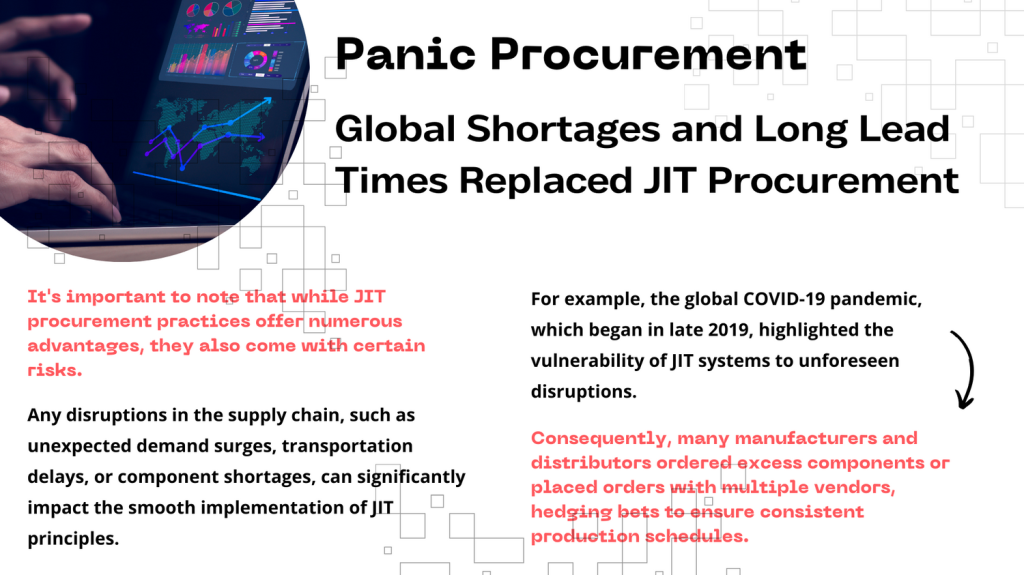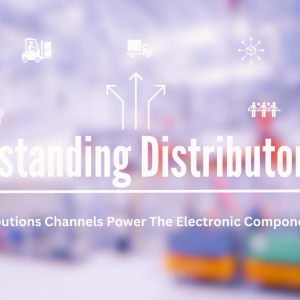Manufacturers and OEMs increasingly practice just-in-time (JIT) procurement practices to enhance efficiency and reduce costs. JIT procurement aims to synchronize the supply of components with the actual demand. This complicated balancing act ensures optimized inventory levels and minimizes costly excess.
Though shortages and long lead times drove some in the industry to stockpile products, managing this excess inventory now presents complex challenges for manufacturers, OEMs, and distributors alike. In this blog, we break down COVID-inspired stockpiling and viable options for handling excess inventory now.
Understanding Just-in-Time Procurement Practices
Just-in-time procurement is a supply chain management approach that seeks to minimize inventory carrying costs. Companies accomplish this chief objective by ordering components precisely when needed for production. JIT Procurement benefits every aspect of the industry, from manufacturers and OEMs to distributors. By implementing JIT principles, electronics manufacturers and OEMs streamline operations, reduce lead times, and improve cash flow.

While JIT Procurement seems like a simple solution, successful implementation requires seamless coordination between suppliers, manufacturers, and distributors.
A well-developed channel marketing plan emphasizing strong partnerships with distribution channel partners improves JIT procurement outcomes. This collaboration ensures the timely availability of materials, avoiding stockouts and surplus inventory.
Panic Procurement and the Myriad Causes of Excess Electronic Component Inventory

Many factors created current surplus challenges.
- Engineering Changes: Frequent engineering changes in electronic devices often result in component obsolescence. Manufacturer product modifications also drive redundancies, furthering excess inventory buildup.
- Supplier Inaccuracies: Supply chains act as an ecosystem, and each part affects the others. When suppliers up the chain issue inaccurate forecasts, distributors much farther down the chain often carry the bulk of the overproduction burden. Delivery delays or quality issues also have the potential to send shock waves up and down the supply chain.
- Economic and Geopolitical Factors: Global economic fluctuations and geopolitical events can disrupt supply chains, causing unforeseen inventory imbalances.
- Mismatched Order Quantities: Volume discounts and minimum order requirements set by suppliers sometimes leave distributors with an overabundance of certain components. While distributors understand the necessity of such bets from time to time, the overstock creates complications.
- Customer Order Cancellations: Project delays, design changes, or unexpected economic conditions can arise at any point in the development and production process. When the unexpected strikes, last-minute cancellations, or changes in customer orders, can leave distributors with surplus components.
- End-of-Life (EOL) Components: Components reaching their end-of-life status can pose a significant challenge for distributors. While some customers may still require them, demand tends to decline, leading to excess inventory.

Handling Excess Inventory To Restore JIT Procurement
Transitioning towards JIT Procurement after a period of panic-driven procurement strategies means companies across the electronic component industry now look to optimize inventory. This transition requires both prevention and mitigation steps that improve the current outlook and prevent future challenges.
To prevent costly surplus issues, distributors invest time and resources into regular inventory audits. Such audits inform procurement, allowing distributors to identify slow-moving or obsolete components. Analyzing these results in the context of historical sales data and market trends improves forecasting accuracy.
Distributors build on the benefits of regular, accurate forecasting by negotiating with suppliers for added protection. Distributors often work closely with suppliers to tailor flexible product return policies or consignment agreements. Such verbiage protects distributors from a costly surplus with the promise of manufacturer or supplier support in the event products halt or change and the distributor is left with overstock.

Distributors whittle existing overstock by offering products at discounts or running incentive programs. Some distributors also consider the secondary market, weighing the lower profit margin offered by aftermarket vendors against the cost of warehousing and moving surplus inventory.
Manufacturers and OEMs look for additional opportunities to adjust component inventory, working with buyers to evaluate BOM orders for opportunities to recommend overstock components in place of new orders. This strategy requires an in-depth understanding of product specs and application functions, but companies with such expertise stand to successfully repurpose more of their surplus component inventory.
Tackle Inventory Surplus and Master JIT Procurement With Mectronic
The electronics components industry’s adoption of just-in-time procurement practices revolutionizes supply chain management for increased efficiency and reduced operational costs. However, excess inventory remains a persistent challenge for the industry, particularly for distributors.
Mectronic remains committed to connecting buyers with the components they need, offering a host of tools and services that move products quickly and reliably. Our hosted and custom applications, integrations, and component part search tools make it easy to address overstock. Contact Mectronic today to learn more about Mectronic products and services to lock in your company’s JIT Procurement strategy.
Interested in the latest trends and innovations in technology? The Mectronic blog is your source for trusted insight into the technology world. Check our blog for regular updates!

Mectronic has been connecting sellers and buyers for 25 years. With powerful search tools and over 300 million products, Mectronic helps you find the B2B components you need from sources you trust. Find the parts and components you need today here!





